Math Lesson Plan: Classifying Triangles for Year 7 Students
VerifiedAdded on 2022/11/15
|5
|2516
|367
Homework Assignment
AI Summary
This document presents a detailed lesson plan designed for Year 7 mathematics students, focusing on the classification of triangles based on their side and angle properties. The lesson begins with an introductory phase where the teacher interacts with students, exchanges introductions, and reviews expected outcomes. The body of the lesson involves the exploration of different triangle types, including equilateral, isosceles, scalene, right-angled, obtuse-angled, and acute-angled triangles. Students are provided with worksheets and grid papers to draw and identify the properties of each triangle type. The lesson incorporates visual aids, drawings, and hands-on activities to enhance understanding. The teacher provides explanations and guides students in differentiating between the various types of triangles. The consolidation phase involves a review of the lesson's key points and assignment of homework. The lesson plan emphasizes experiential learning, problem-solving, and visual learning to facilitate student understanding and engagement.
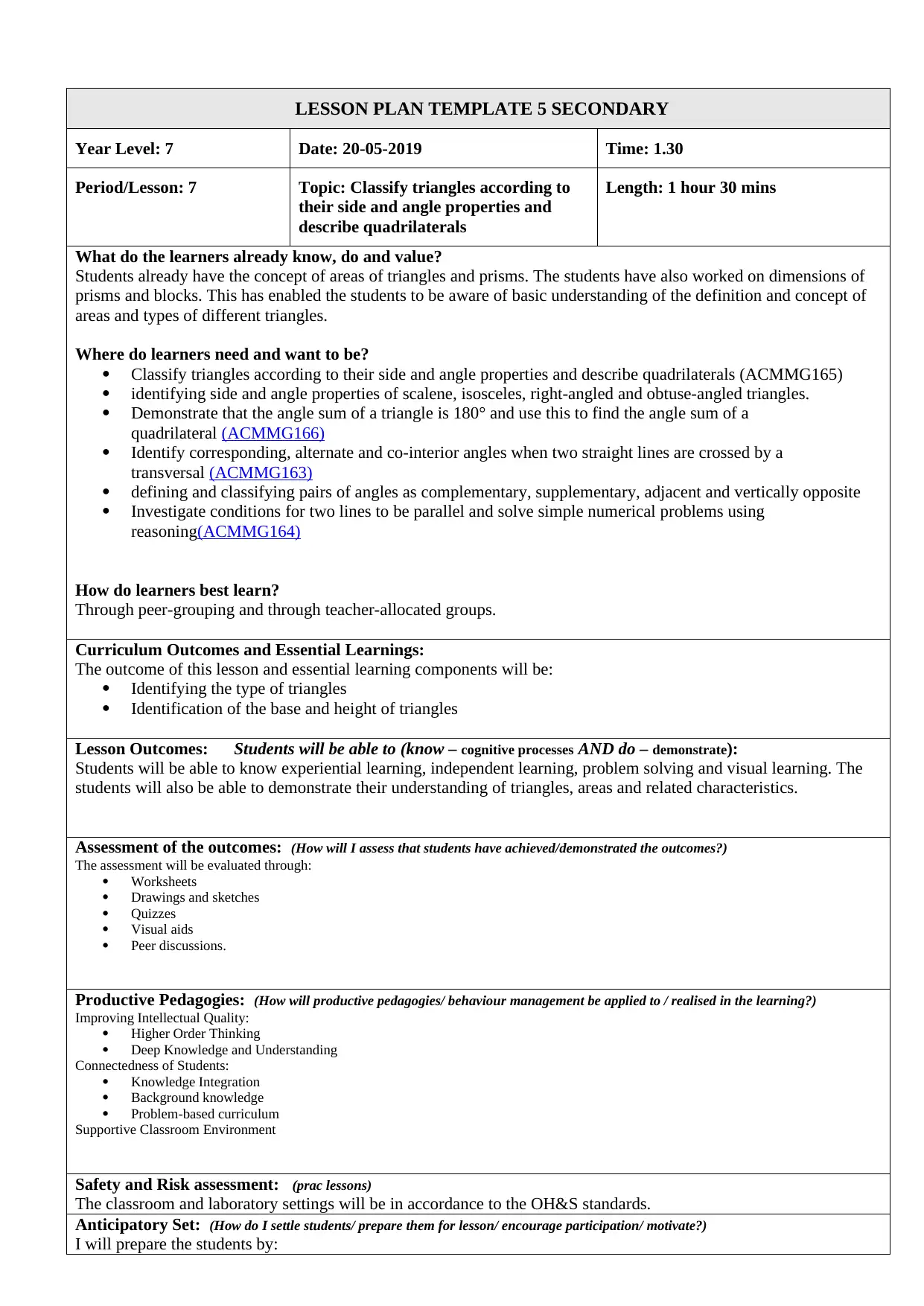
LESSON PLAN TEMPLATE 5 SECONDARY
Year Level: 7 Date: 20-05-2019 Time: 1.30
Period/Lesson: 7 Topic: Classify triangles according to
their side and angle properties and
describe quadrilaterals
Length: 1 hour 30 mins
What do the learners already know, do and value?
Students already have the concept of areas of triangles and prisms. The students have also worked on dimensions of
prisms and blocks. This has enabled the students to be aware of basic understanding of the definition and concept of
areas and types of different triangles.
Where do learners need and want to be?
Classify triangles according to their side and angle properties and describe quadrilaterals (ACMMG165)
identifying side and angle properties of scalene, isosceles, right-angled and obtuse-angled triangles.
Demonstrate that the angle sum of a triangle is 180° and use this to find the angle sum of a
quadrilateral (ACMMG166)
Identify corresponding, alternate and co-interior angles when two straight lines are crossed by a
transversal (ACMMG163)
defining and classifying pairs of angles as complementary, supplementary, adjacent and vertically opposite
Investigate conditions for two lines to be parallel and solve simple numerical problems using
reasoning(ACMMG164)
How do learners best learn?
Through peer-grouping and through teacher-allocated groups.
Curriculum Outcomes and Essential Learnings:
The outcome of this lesson and essential learning components will be:
Identifying the type of triangles
Identification of the base and height of triangles
Lesson Outcomes: Students will be able to (know – cognitive processes AND do – demonstrate):
Students will be able to know experiential learning, independent learning, problem solving and visual learning. The
students will also be able to demonstrate their understanding of triangles, areas and related characteristics.
Assessment of the outcomes: (How will I assess that students have achieved/demonstrated the outcomes?)
The assessment will be evaluated through:
Worksheets
Drawings and sketches
Quizzes
Visual aids
Peer discussions.
Productive Pedagogies: (How will productive pedagogies/ behaviour management be applied to / realised in the learning?)
Improving Intellectual Quality:
Higher Order Thinking
Deep Knowledge and Understanding
Connectedness of Students:
Knowledge Integration
Background knowledge
Problem-based curriculum
Supportive Classroom Environment
Safety and Risk assessment: (prac lessons)
The classroom and laboratory settings will be in accordance to the OH&S standards.
Anticipatory Set: (How do I settle students/ prepare them for lesson/ encourage participation/ motivate?)
I will prepare the students by:
Year Level: 7 Date: 20-05-2019 Time: 1.30
Period/Lesson: 7 Topic: Classify triangles according to
their side and angle properties and
describe quadrilaterals
Length: 1 hour 30 mins
What do the learners already know, do and value?
Students already have the concept of areas of triangles and prisms. The students have also worked on dimensions of
prisms and blocks. This has enabled the students to be aware of basic understanding of the definition and concept of
areas and types of different triangles.
Where do learners need and want to be?
Classify triangles according to their side and angle properties and describe quadrilaterals (ACMMG165)
identifying side and angle properties of scalene, isosceles, right-angled and obtuse-angled triangles.
Demonstrate that the angle sum of a triangle is 180° and use this to find the angle sum of a
quadrilateral (ACMMG166)
Identify corresponding, alternate and co-interior angles when two straight lines are crossed by a
transversal (ACMMG163)
defining and classifying pairs of angles as complementary, supplementary, adjacent and vertically opposite
Investigate conditions for two lines to be parallel and solve simple numerical problems using
reasoning(ACMMG164)
How do learners best learn?
Through peer-grouping and through teacher-allocated groups.
Curriculum Outcomes and Essential Learnings:
The outcome of this lesson and essential learning components will be:
Identifying the type of triangles
Identification of the base and height of triangles
Lesson Outcomes: Students will be able to (know – cognitive processes AND do – demonstrate):
Students will be able to know experiential learning, independent learning, problem solving and visual learning. The
students will also be able to demonstrate their understanding of triangles, areas and related characteristics.
Assessment of the outcomes: (How will I assess that students have achieved/demonstrated the outcomes?)
The assessment will be evaluated through:
Worksheets
Drawings and sketches
Quizzes
Visual aids
Peer discussions.
Productive Pedagogies: (How will productive pedagogies/ behaviour management be applied to / realised in the learning?)
Improving Intellectual Quality:
Higher Order Thinking
Deep Knowledge and Understanding
Connectedness of Students:
Knowledge Integration
Background knowledge
Problem-based curriculum
Supportive Classroom Environment
Safety and Risk assessment: (prac lessons)
The classroom and laboratory settings will be in accordance to the OH&S standards.
Anticipatory Set: (How do I settle students/ prepare them for lesson/ encourage participation/ motivate?)
I will prepare the students by:
Paraphrase This Document
Need a fresh take? Get an instant paraphrase of this document with our AI Paraphraser
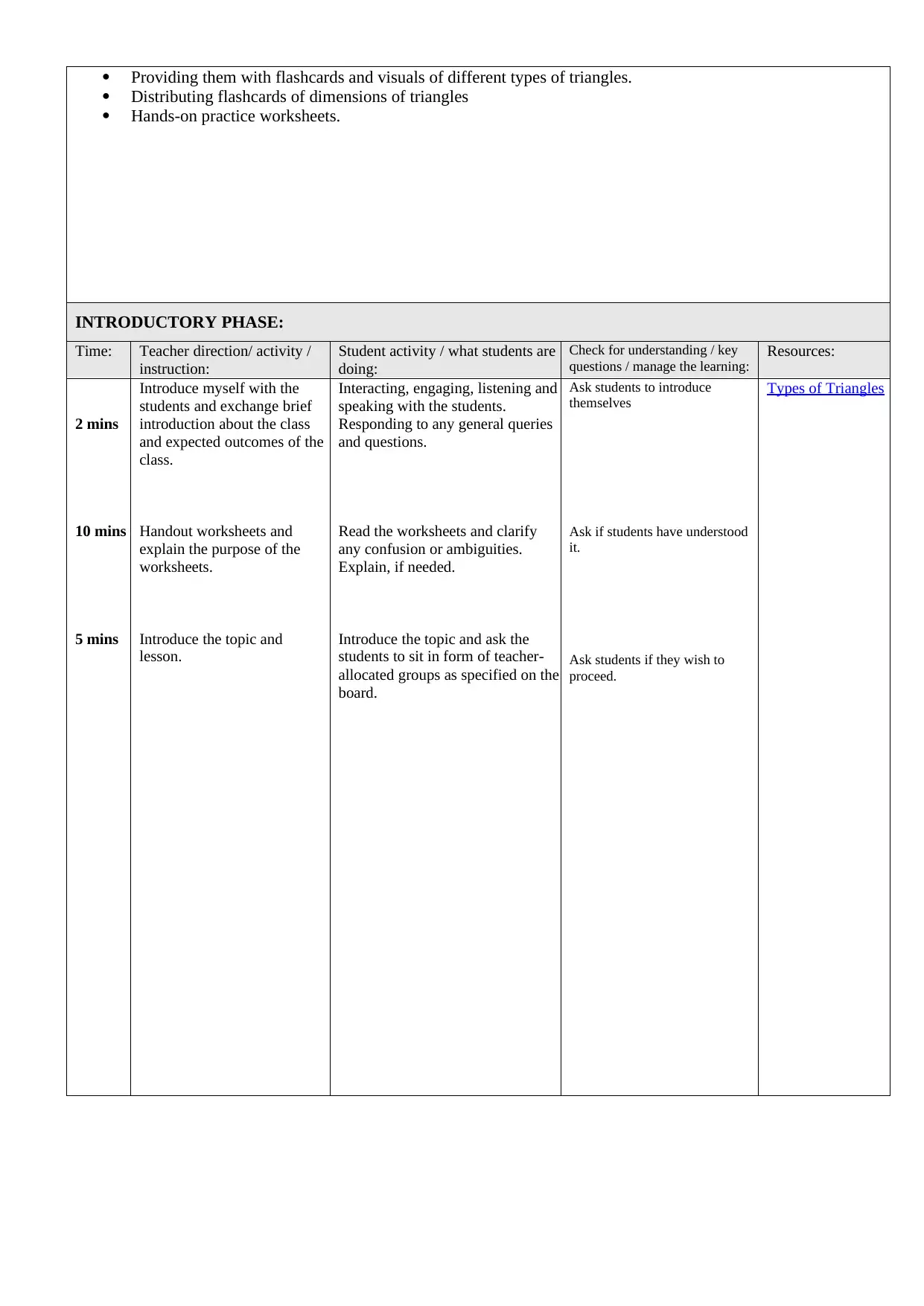
Providing them with flashcards and visuals of different types of triangles.
Distributing flashcards of dimensions of triangles
Hands-on practice worksheets.
INTRODUCTORY PHASE:
Time: Teacher direction/ activity /
instruction:
Student activity / what students are
doing:
Check for understanding / key
questions / manage the learning:
Resources:
2 mins
10 mins
5 mins
Introduce myself with the
students and exchange brief
introduction about the class
and expected outcomes of the
class.
Handout worksheets and
explain the purpose of the
worksheets.
Introduce the topic and
lesson.
Interacting, engaging, listening and
speaking with the students.
Responding to any general queries
and questions.
Read the worksheets and clarify
any confusion or ambiguities.
Explain, if needed.
Introduce the topic and ask the
students to sit in form of teacher-
allocated groups as specified on the
board.
Ask students to introduce
themselves
Ask if students have understood
it.
Ask students if they wish to
proceed.
Types of Triangles
Distributing flashcards of dimensions of triangles
Hands-on practice worksheets.
INTRODUCTORY PHASE:
Time: Teacher direction/ activity /
instruction:
Student activity / what students are
doing:
Check for understanding / key
questions / manage the learning:
Resources:
2 mins
10 mins
5 mins
Introduce myself with the
students and exchange brief
introduction about the class
and expected outcomes of the
class.
Handout worksheets and
explain the purpose of the
worksheets.
Introduce the topic and
lesson.
Interacting, engaging, listening and
speaking with the students.
Responding to any general queries
and questions.
Read the worksheets and clarify
any confusion or ambiguities.
Explain, if needed.
Introduce the topic and ask the
students to sit in form of teacher-
allocated groups as specified on the
board.
Ask students to introduce
themselves
Ask if students have understood
it.
Ask students if they wish to
proceed.
Types of Triangles
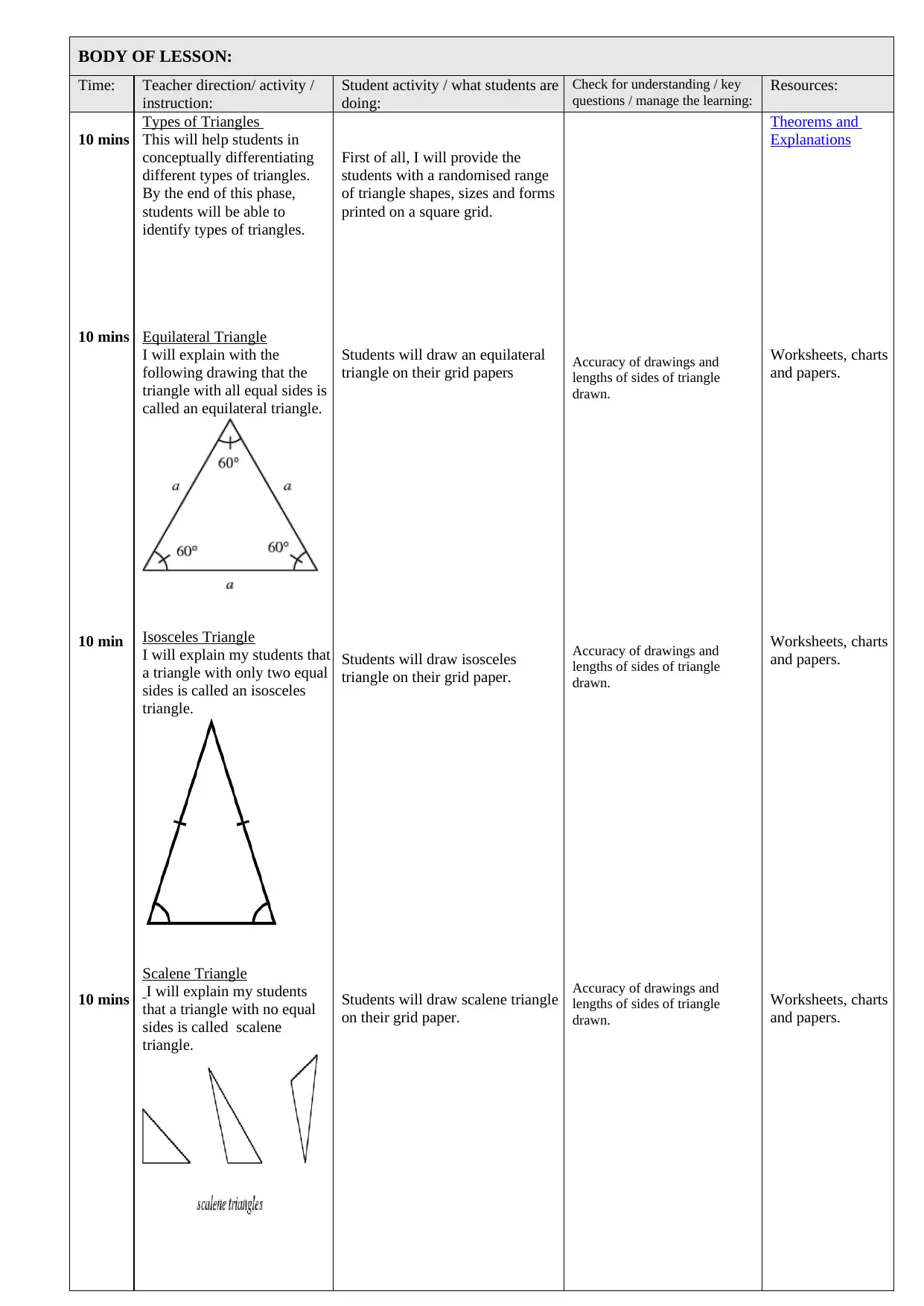
BODY OF LESSON:
Time: Teacher direction/ activity /
instruction:
Student activity / what students are
doing:
Check for understanding / key
questions / manage the learning:
Resources:
10 mins
10 mins
10 min
10 mins
Types of Triangles
This will help students in
conceptually differentiating
different types of triangles.
By the end of this phase,
students will be able to
identify types of triangles.
Equilateral Triangle
I will explain with the
following drawing that the
triangle with all equal sides is
called an equilateral triangle.
Isosceles Triangle
I will explain my students that
a triangle with only two equal
sides is called an isosceles
triangle.
Scalene Triangle
I will explain my students
that a triangle with no equal
sides is called scalene
triangle.
First of all, I will provide the
students with a randomised range
of triangle shapes, sizes and forms
printed on a square grid.
Students will draw an equilateral
triangle on their grid papers
Students will draw isosceles
triangle on their grid paper.
Students will draw scalene triangle
on their grid paper.
Accuracy of drawings and
lengths of sides of triangle
drawn.
Accuracy of drawings and
lengths of sides of triangle
drawn.
Accuracy of drawings and
lengths of sides of triangle
drawn.
Theorems and
Explanations
Worksheets, charts
and papers.
Worksheets, charts
and papers.
Worksheets, charts
and papers.
Time: Teacher direction/ activity /
instruction:
Student activity / what students are
doing:
Check for understanding / key
questions / manage the learning:
Resources:
10 mins
10 mins
10 min
10 mins
Types of Triangles
This will help students in
conceptually differentiating
different types of triangles.
By the end of this phase,
students will be able to
identify types of triangles.
Equilateral Triangle
I will explain with the
following drawing that the
triangle with all equal sides is
called an equilateral triangle.
Isosceles Triangle
I will explain my students that
a triangle with only two equal
sides is called an isosceles
triangle.
Scalene Triangle
I will explain my students
that a triangle with no equal
sides is called scalene
triangle.
First of all, I will provide the
students with a randomised range
of triangle shapes, sizes and forms
printed on a square grid.
Students will draw an equilateral
triangle on their grid papers
Students will draw isosceles
triangle on their grid paper.
Students will draw scalene triangle
on their grid paper.
Accuracy of drawings and
lengths of sides of triangle
drawn.
Accuracy of drawings and
lengths of sides of triangle
drawn.
Accuracy of drawings and
lengths of sides of triangle
drawn.
Theorems and
Explanations
Worksheets, charts
and papers.
Worksheets, charts
and papers.
Worksheets, charts
and papers.
⊘ This is a preview!⊘
Do you want full access?
Subscribe today to unlock all pages.

Trusted by 1+ million students worldwide
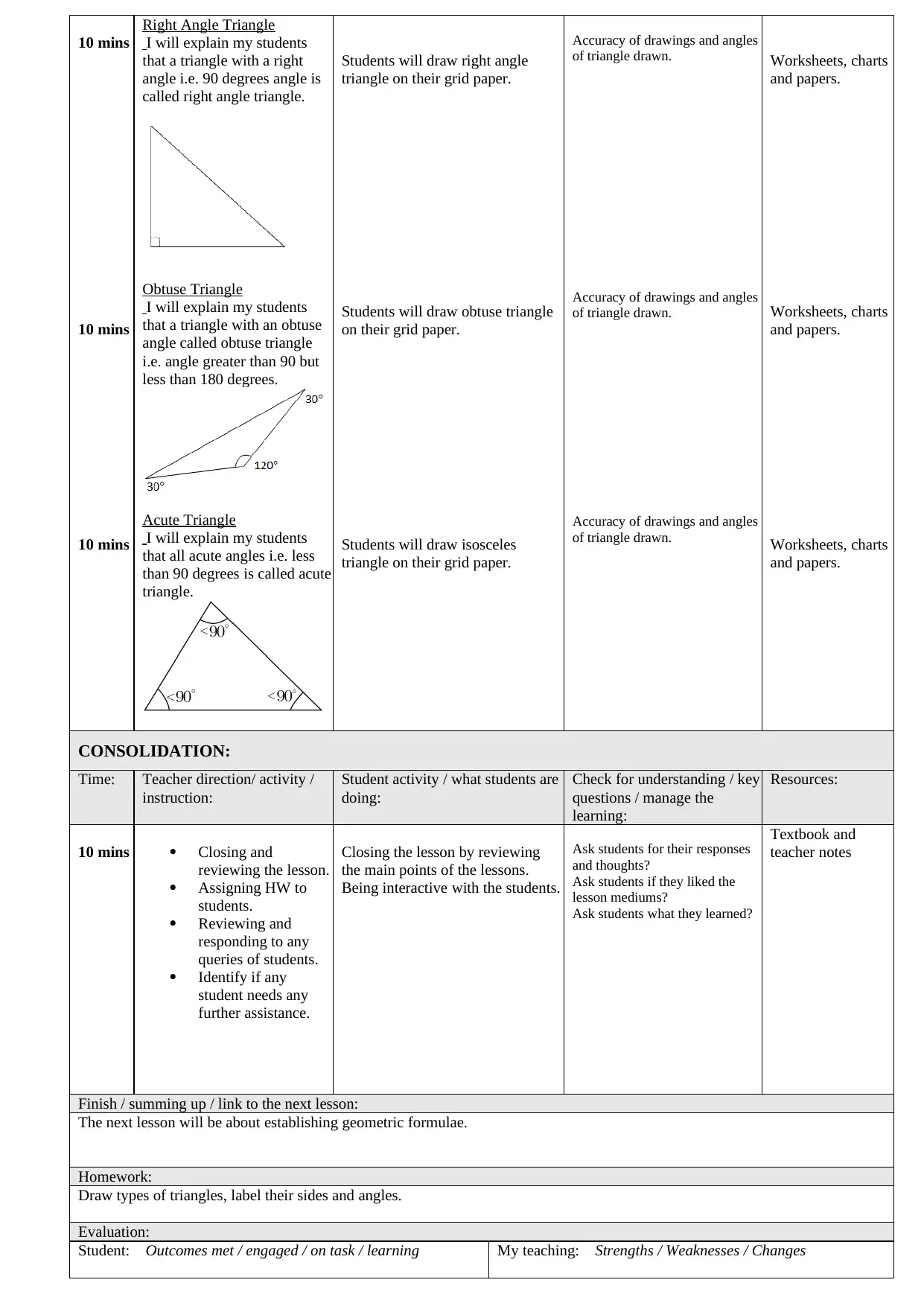
10 mins
10 mins
10 mins
Right Angle Triangle
I will explain my students
that a triangle with a right
angle i.e. 90 degrees angle is
called right angle triangle.
Obtuse Triangle
I will explain my students
that a triangle with an obtuse
angle called obtuse triangle
i.e. angle greater than 90 but
less than 180 degrees.
Acute Triangle
I will explain my students
that all acute angles i.e. less
than 90 degrees is called acute
triangle.
Students will draw right angle
triangle on their grid paper.
Students will draw obtuse triangle
on their grid paper.
Students will draw isosceles
triangle on their grid paper.
Accuracy of drawings and angles
of triangle drawn.
Accuracy of drawings and angles
of triangle drawn.
Accuracy of drawings and angles
of triangle drawn.
Worksheets, charts
and papers.
Worksheets, charts
and papers.
Worksheets, charts
and papers.
CONSOLIDATION:
Time: Teacher direction/ activity /
instruction:
Student activity / what students are
doing:
Check for understanding / key
questions / manage the
learning:
Resources:
10 mins Closing and
reviewing the lesson.
Assigning HW to
students.
Reviewing and
responding to any
queries of students.
Identify if any
student needs any
further assistance.
Closing the lesson by reviewing
the main points of the lessons.
Being interactive with the students.
Ask students for their responses
and thoughts?
Ask students if they liked the
lesson mediums?
Ask students what they learned?
Textbook and
teacher notes
Finish / summing up / link to the next lesson:
The next lesson will be about establishing geometric formulae.
Homework:
Draw types of triangles, label their sides and angles.
Evaluation:
Student: Outcomes met / engaged / on task / learning My teaching: Strengths / Weaknesses / Changes
10 mins
10 mins
Right Angle Triangle
I will explain my students
that a triangle with a right
angle i.e. 90 degrees angle is
called right angle triangle.
Obtuse Triangle
I will explain my students
that a triangle with an obtuse
angle called obtuse triangle
i.e. angle greater than 90 but
less than 180 degrees.
Acute Triangle
I will explain my students
that all acute angles i.e. less
than 90 degrees is called acute
triangle.
Students will draw right angle
triangle on their grid paper.
Students will draw obtuse triangle
on their grid paper.
Students will draw isosceles
triangle on their grid paper.
Accuracy of drawings and angles
of triangle drawn.
Accuracy of drawings and angles
of triangle drawn.
Accuracy of drawings and angles
of triangle drawn.
Worksheets, charts
and papers.
Worksheets, charts
and papers.
Worksheets, charts
and papers.
CONSOLIDATION:
Time: Teacher direction/ activity /
instruction:
Student activity / what students are
doing:
Check for understanding / key
questions / manage the
learning:
Resources:
10 mins Closing and
reviewing the lesson.
Assigning HW to
students.
Reviewing and
responding to any
queries of students.
Identify if any
student needs any
further assistance.
Closing the lesson by reviewing
the main points of the lessons.
Being interactive with the students.
Ask students for their responses
and thoughts?
Ask students if they liked the
lesson mediums?
Ask students what they learned?
Textbook and
teacher notes
Finish / summing up / link to the next lesson:
The next lesson will be about establishing geometric formulae.
Homework:
Draw types of triangles, label their sides and angles.
Evaluation:
Student: Outcomes met / engaged / on task / learning My teaching: Strengths / Weaknesses / Changes
Paraphrase This Document
Need a fresh take? Get an instant paraphrase of this document with our AI Paraphraser
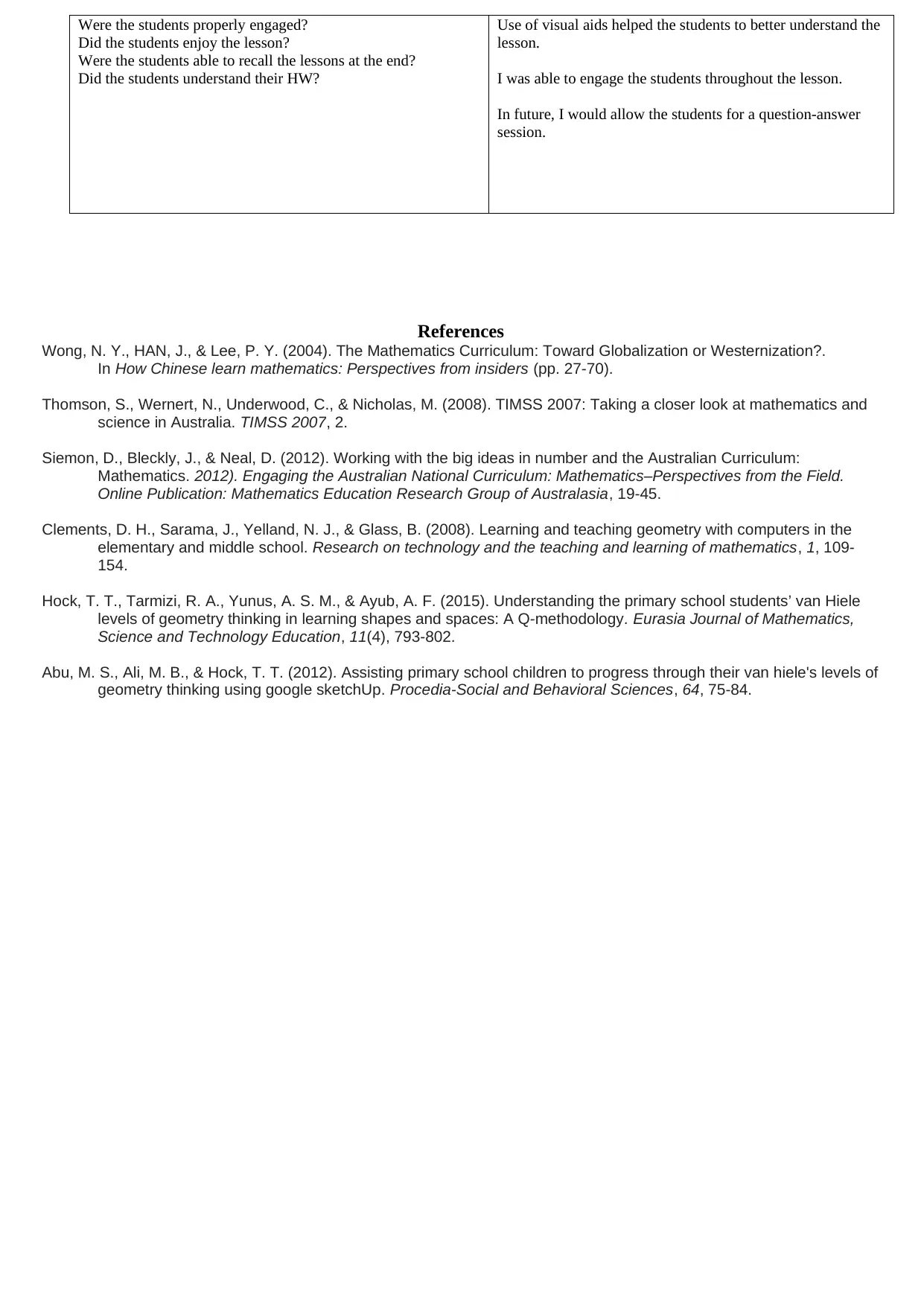
Were the students properly engaged?
Did the students enjoy the lesson?
Were the students able to recall the lessons at the end?
Did the students understand their HW?
Use of visual aids helped the students to better understand the
lesson.
I was able to engage the students throughout the lesson.
In future, I would allow the students for a question-answer
session.
References
Wong, N. Y., HAN, J., & Lee, P. Y. (2004). The Mathematics Curriculum: Toward Globalization or Westernization?.
In How Chinese learn mathematics: Perspectives from insiders (pp. 27-70).
Thomson, S., Wernert, N., Underwood, C., & Nicholas, M. (2008). TIMSS 2007: Taking a closer look at mathematics and
science in Australia. TIMSS 2007, 2.
Siemon, D., Bleckly, J., & Neal, D. (2012). Working with the big ideas in number and the Australian Curriculum:
Mathematics. 2012). Engaging the Australian National Curriculum: Mathematics–Perspectives from the Field.
Online Publication: Mathematics Education Research Group of Australasia, 19-45.
Clements, D. H., Sarama, J., Yelland, N. J., & Glass, B. (2008). Learning and teaching geometry with computers in the
elementary and middle school. Research on technology and the teaching and learning of mathematics, 1, 109-
154.
Hock, T. T., Tarmizi, R. A., Yunus, A. S. M., & Ayub, A. F. (2015). Understanding the primary school students’ van Hiele
levels of geometry thinking in learning shapes and spaces: A Q-methodology. Eurasia Journal of Mathematics,
Science and Technology Education, 11(4), 793-802.
Abu, M. S., Ali, M. B., & Hock, T. T. (2012). Assisting primary school children to progress through their van hiele's levels of
geometry thinking using google sketchUp. Procedia-Social and Behavioral Sciences, 64, 75-84.
Did the students enjoy the lesson?
Were the students able to recall the lessons at the end?
Did the students understand their HW?
Use of visual aids helped the students to better understand the
lesson.
I was able to engage the students throughout the lesson.
In future, I would allow the students for a question-answer
session.
References
Wong, N. Y., HAN, J., & Lee, P. Y. (2004). The Mathematics Curriculum: Toward Globalization or Westernization?.
In How Chinese learn mathematics: Perspectives from insiders (pp. 27-70).
Thomson, S., Wernert, N., Underwood, C., & Nicholas, M. (2008). TIMSS 2007: Taking a closer look at mathematics and
science in Australia. TIMSS 2007, 2.
Siemon, D., Bleckly, J., & Neal, D. (2012). Working with the big ideas in number and the Australian Curriculum:
Mathematics. 2012). Engaging the Australian National Curriculum: Mathematics–Perspectives from the Field.
Online Publication: Mathematics Education Research Group of Australasia, 19-45.
Clements, D. H., Sarama, J., Yelland, N. J., & Glass, B. (2008). Learning and teaching geometry with computers in the
elementary and middle school. Research on technology and the teaching and learning of mathematics, 1, 109-
154.
Hock, T. T., Tarmizi, R. A., Yunus, A. S. M., & Ayub, A. F. (2015). Understanding the primary school students’ van Hiele
levels of geometry thinking in learning shapes and spaces: A Q-methodology. Eurasia Journal of Mathematics,
Science and Technology Education, 11(4), 793-802.
Abu, M. S., Ali, M. B., & Hock, T. T. (2012). Assisting primary school children to progress through their van hiele's levels of
geometry thinking using google sketchUp. Procedia-Social and Behavioral Sciences, 64, 75-84.
1 out of 5
Related Documents
Your All-in-One AI-Powered Toolkit for Academic Success.
+13062052269
info@desklib.com
Available 24*7 on WhatsApp / Email
![[object Object]](/_next/static/media/star-bottom.7253800d.svg)
Unlock your academic potential
Copyright © 2020–2025 A2Z Services. All Rights Reserved. Developed and managed by ZUCOL.

